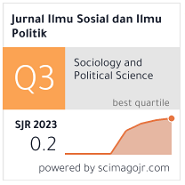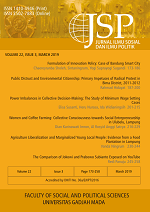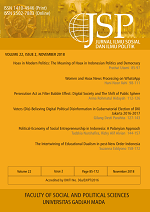The Role of the Ambon City’s Population and Civil Registration Office in Controlling Incoming Migration
Rahmawati Sururama(1*), Tiara Nanuru(2)
(1) Department of Local Government Administration, Faculty of Government Management, Institut Pemerintahan Dalam Negeri
(2) Inspectorate Service of North Maluku Ministry
(*) Corresponding Author
Abstract
The objectives of this study are to find out the role of the Ambon City’s Population and Civil Registration Office in Controlling Incoming Migration and to find out the obstacles faced by the Ambon City's Population and Civil Registration Office in Controlling Incoming Migration. This study used a qualitative descriptive research method. Data Collection was obtained through observation, interview, and documentation. Data were analyzed using data reduction, display data, and verification. Primary and secondary data were used as the sources for analysis. The informants in this study were the chief of the Population and Civil Registration Office Ambon City and the Population Monitoring and Control Division, as well as the migrants. Ambon City’s Government, through the Population and Civil Registration Office, has carried out its duties as regulated by the Mayor of Ambon Regulation No. 17/ 2009 article 14 paragraph 2, namely: Coordinating the monitoring of urbanization of population and supervising the registration of population mobility flows. The constraints faced by the Ambon City population and civil registration office, namely: Most of the population who migrated to Ambon City did not report themselves so the authorities had difficulty monitoring the flow of urbanization and monitoring population mobility; inspected and supervised residents, who have not lived in Ambon city for six months, have moved to other areas; there is no effort and awareness of people who have been examined and under supervision to change by reporting personal data to the government.
Keywords
Full Text:
PDFReferences
Akay, A., Bargain, O., & Zimmermann, K. F. (2012). Relative concerns of rural-to-urban migrants in China. Journal of Economic Behavior and Organization, 81(2), 421-441. doi: 10.1016/j.jebo.2011.12.006
Amare, M., Hohfeld, L., Jitsuchon, S., & Waibel, A. H. (2012). Rural-Urban migration and employment quality: A case study from Thailand. Asian Development Review, 281(1), 57-59.
Ambon City’s Goverment. (2009). Job Description of Structural Position in Ambon City Population and Civil Registration Service (No. 17/2009). Ambon: Ambon City's Government.
Anas, A. Y., Riana, A. W., & Apsari, N. C. (2015). Desa dan Kota Dalam Potret Pendidikan. Procceding Penelitian Dan Pengabdian Kepada Masyarakat. Sumedang: Departemen Kesejahteraan Sosial, Universitas Padjajaran. Retrieved from https://jurnal.unpad.ac.id/prosiding/article/view/13592
Anh, N. T., Rigg, J., Huong, L. T. T., & Dieu, D. T. (2012). Becoming and being urban in Hanoi: Rural-urban migration and relations in Viet Nam. Journal of Peasant Studies, 39(5), 1103-1131. doi: 10.1080/03066150.2011.652618
Azam, J. P., & Gubert, F. (2006). Migrants’ remittances and the household in Africa: A review of evidence. Journal of African Economies, 15(2), 426-462 .doi.org/10.1093/jae/ejl030
Badan Pusat Statistik. (2016). Penduduk provinsi Maluku menurut Kabupaten Kota. Retrieved June 25, 2018, from https://maluku. bps.go.id/statictable/2016/09/14/179/ penduduk-provinsi-maluku-menurut- kabupaten-kota-1961---2020.html
Badan Pusat Statistik. (2010). Penduduk menurut wilayah, jenis kelamin, dan status migrasi seumur hidup Propinsi Maluku. Retrieved June 25, 2018, from https:// sp2010.bps.go.id/ index.php/ site/ tabel?tid=324&wid=8100000000
Badan Pusat Statistik. (2010). Penduduk 5 tahun keatas menurut wilayah, jenis kelamin, dan status migrasi Risen, Provinsi Maluku. Retrieved June 25, 2018, from https:// sp2010. bps.go.id/index.php/site/tabel?sea rchtabel=Penduduk+5+Tahun+Keatas+Meurut+Wilayah%2C+Jenis+Kelamin%2C+d an+Status+Migrasi+Risen&tid=272&search
Black, R., Adger, W. N., Arnell, N. W., Dercon, S., Geddes, A., & Thomas, D. (2011). The effect of environmental change on human migration. Global Environmental Change, 21(1), S3-S11. doi: 10.1016/j.gloenvcha.2011.10.001
Dinas Pariwisata Maluku. (2018). Jumlah kunjungan wisataw an ke Maluku meningkat 20 Persen. Retrieved August 30, 2019, from https://kum paran. com/ambonnesia/ jumlah-kunjungan- wisatawan-ke-maluku-meningkat-20- persen-153556061261076169
de Brauw, A., & Harigaya, T. (2007). Seasonal migration and improving living standards in Vietnam. American Journal of Agricultural Economics, 89(2), 430-447. doi: 10.1111/j.1467-8276.2006.00989.x
De Haas, H. (2010). Migration and development: A theoretical perspective. International Migration Review, 44(1). doi: 10.1111/j.1747-7379.2009.00804.x
de la Fuente, A. (2010). Remittances and vulnerability to poverty in rural Mexico. World Development, 38(6), 829-839. doi: 10.1016/j.worlddev.2010.02.002
Duverger, M. (2010). Sosiologi politik. Jakarta: PT. Rajagrafindo Persada.
Garip, F. (2014). The Impact of Migration and Remittances on Wealth Accumulation and Distribution in Rural Thailand. Demography. https://doi.org/10.1007/s13524-013-0260-y
Government Of The Republic Of Indonesia. (2006). Population Administration (No.23/2006). Jakarta: Government of The Republic of Indonesia
Hartmann, B. (2010). Rethinking climate refugees and climate conflict: Rhetoric, reality and the politics of policy discourse. Journal of International Developmen, 22(2), 233-246. doi: 10.1002/jid.1676
Haug, S. (2008). Migration networks and migration decision-making. Journal of Ethnic and Migration Studies, 34(4), 585-605. doi: 10.1080/13691830801961605
Kartiki, K. (2011). Climate change and migration: A case study from rural Bangladesh. Gender and Development, 19(1), 23-28. doi: 10.1080/13552074.2011.554017
Kusuma Y. S., Pandav, C. S., Babu, B. V. (2014). Socio-demographic profile of socioeconomically disadvantaged internal migrants in Delhi. Journal of Identity and Migration Studies, 8(2), 37–49.
Labolo, M. (2011). Memahami ilmu pemerintahan. Jakarta: PT. Rajagrafindo Persada.
Lee, E. S. (1966).A theory of migration. Demography, 3(1), 47–57. doi: 10.2307/2060063
Lumbantoruan, W. (2009). Analisis migrasi penduduk ke Desa Ndokumsiroga Kecamatan Simpang Empat Kabupaten Karo. Journal Geografi, 1(1), 43-49.
Mantra, I. B. (2013). Demografi Umum. Yogyakarta: Pustaka Pelajar.
Minister of Home Affairs. (2015). Guidelines for registration of Non-German Residents (No. 14/2015). Jakarta: Minister of Home Affairs
Nguyen, L. D., Raabe, K., & Grote, U. (2015). Rural-Urban Migration, Household Vulnerability, and Welfare in Vietnam. World Development, 71(C), 79-93. doi: 10.1016/j.worlddev.2013.11.002
Sunarto, Hs. (1991). Dampak migrasi sirkuler terhadap desa asal migran. Jurnal Populasi,
2(2), 37-44. doi: 10.22146/jp.10805
Soekanto, S. (2010). Sosiologi suatu pengantar. Jakarta: PT. Rajagrafindo Persada.
Sugiyono. (2015). Metode Penelitian Manajemen. Bandung: Alfabeta.
Syafiie, I. K. (2011). Etika Pemerintahan. Jakarta: PT Rineka Cipta.
Todaro, Michael P. (1979). Economic for Developing World, Introduction to a principles Problems and Policies . Hongkong: Longman
Zhao, Y. (1999). Labor Migration and Earnings Differences: The Case of Rural China. Economic Development and Cultural Change. 47(4), 762-782. doi: 10.1086/452431
Article Metrics
Refbacks
- There are currently no refbacks.
Copyright (c) 2019 Jurnal Ilmu Sosial dan Ilmu Politik

This work is licensed under a Creative Commons Attribution-NonCommercial-NoDerivatives 4.0 International License.






















